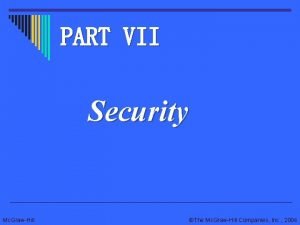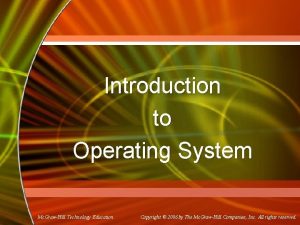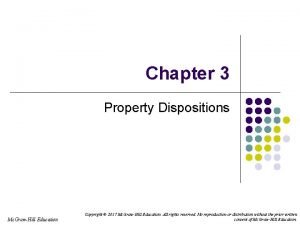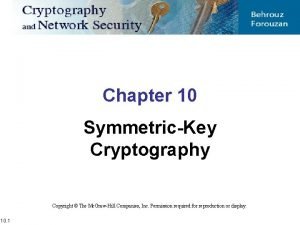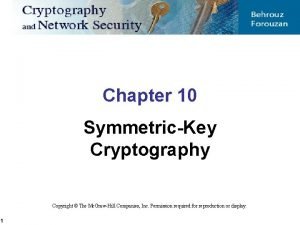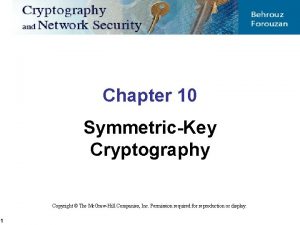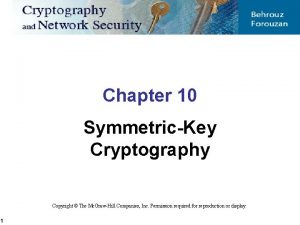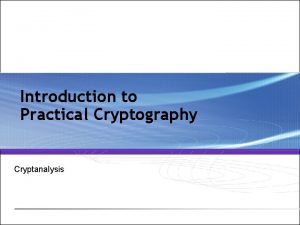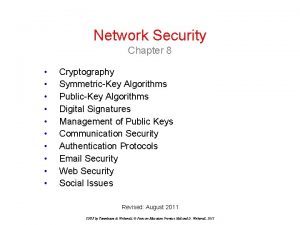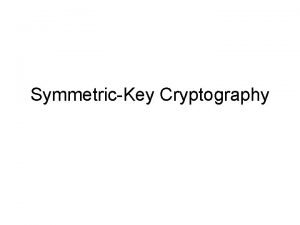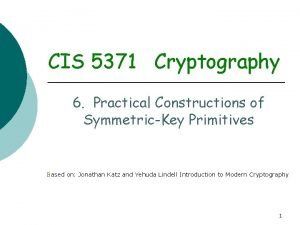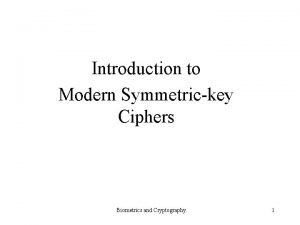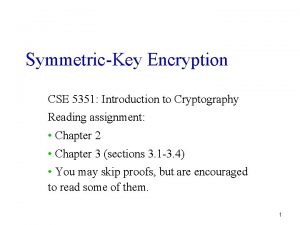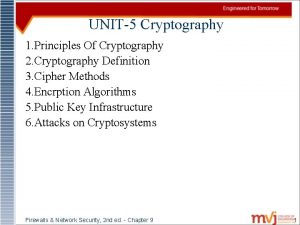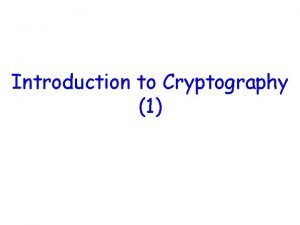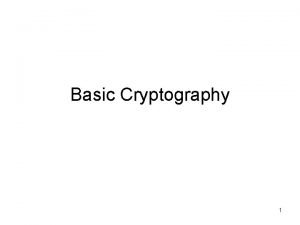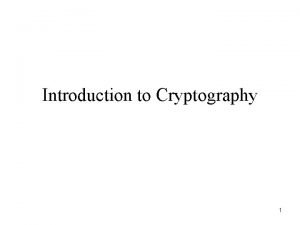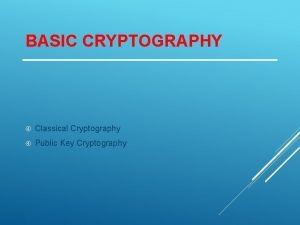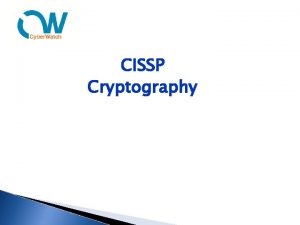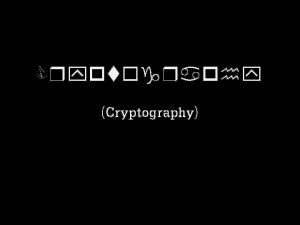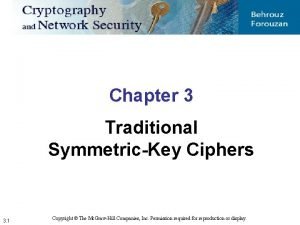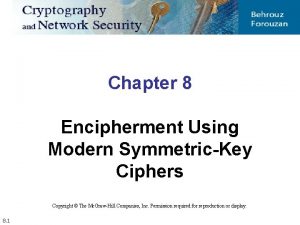Chapter 10 SymmetricKey Cryptography Copyright The Mc GrawHill
















































- Slides: 48

Chapter 10 Symmetric-Key Cryptography Copyright © The Mc. Graw-Hill Companies, Inc. Permission required for reproduction or display. 10. 1

Chapter 10 Objectives q To distinguish between two cryptosystems: symmetric-key and asymmetric-key q To introduce trapdoor one-way functions and their use in asymmetric-key cryptosystems q To discuss the RSA cryptosystem q To discuss the Rabin cryptosystem (10. 3 Later) q To discuss the El. Gamal cryptosystem 10. 2

10 -1 INTRODUCTION Symmetric and asymmetric-key cryptography will exist in parallel and continue to serve the community. We actually believe that they are complements of each other; the advantages of one can compensate for the disadvantages of the other. Topics discussed in this section: 10. 1. 1 10. 1. 2 10. 1. 3 10. 1. 4 10. 1. 5 10. 3 Keys General Idea Need for Both Trapdoor One-Way Function Knapsack Cryptosystem

10 -1 INTRODUCTION Symmetric and asymmetric-key cryptography will exist in parallel and continue to serve the community. We actually believe that they are complements of each other; the advantages of one can compensate for the disadvantages of the other. Note Symmetric-key cryptography is based on sharing secrecy; asymmetric-key cryptography is based on personal secrecy. 10. 4

10. 1. 1 Keys Asymmetric key cryptography uses two separate keys: one private and one public. Figure 10. 1 Locking and unlocking in asymmetric-key cryptosystem 10. 5

10. 1. 2 General Idea Figure 10. 2 General idea of asymmetric-key cryptosystem 10. 6

10. 1. 2 Continued Plaintext/Ciphertext Unlike in symmetric-key cryptography, plaintext and ciphertext are treated as integers in asymmetric-key cryptography. Encryption/Decryption C = f (Kpublic , P) 10. 7 P = g(Kprivate , C)

10. 1. 3 Need for Both There is a very important fact that is sometimes misunderstood: The advent of asymmetric-key cryptography does not eliminate the need for symmetrickey cryptography. 10. 8

10. 1. 4 Trapdoor One-Way Function The main idea behind asymmetric-key cryptography is the concept of the trapdoor one-way function. Functions Figure 10. 3 A function as rule mapping a domain to a range 10. 9

10. 1. 4 Continued One-Way Function (OWF) 1. f is easy to compute. 2. f − 1 is difficult to compute. Trapdoor One-Way Function (TOWF) 3. Given y and a trapdoor, x can be computed easily. 10. 10

10. 1. 4 Continued Example 10. 1 When n is large, n = p × q is a one-way function. Given p and q , it is always easy to calculate n ; given n, it is very difficult to compute p and q. This is the factorization problem. Example 10. 2 When n is large, the function y = xk mod n is a trapdoor oneway function. Given x, k, and n, it is easy to calculate y. Given y, k, and n, it is very difficult to calculate x. This is the discrete logarithm problem. However, if we know the trapdoor, k′ such that k × k ′ = 1 mod f(n), we can use x = yk′ mod n to find x. 10. 11

10 -2 RSA CRYPTOSYSTEM The most common public-key algorithm is the RSA cryptosystem, named for its inventors (Rivest, Shamir, and Adleman). Topics discussed in this section: 10. 2. 1 10. 2. 2 10. 2. 3 10. 2. 4 10. 2. 5 10. 2. 6 10. 2. 7 10. 12 Introduction Procedure Some Trivial Examples Attacks on RSA Recommendations Optimal Asymmetric Encryption Padding (OAEP) Applications

10. 2. 1 Introduction Figure 10. 5 Complexity of operations in RSA 10. 13

10. 2. 2 Procedure Figure 10. 6 Encryption, decryption, and key generation in RSA 10. 14

10. 2. 2 Continued Two Algebraic Structures Encryption/Decryption Ring: Key-Generation Group: 10. 15 R = <Zn , +, × > G = <Z f(n)∗, × >

10. 2. 2 Continued 10. 16

10. 2. 2 Continued Encryption 10. 17

10. 2. 2 Continued Decryption 10. 18

10. 2. 2 Continued Proof of RSA 10. 19

10. 2. 3 Some Trivial Examples Example 10. 5 Bob chooses 7 and 11 as p and q and calculates n = 77. The value of f(n) = (7 − 1)(11 − 1) or 60. Now he chooses two exponents, e and d, from Z 60∗. If he chooses e to be 13, then d is 37. Note that e × d mod 60 = 1 (they are inverses of each Now imagine that Alice wants to send the plaintext 5 to Bob. She uses the public exponent 13 to encrypt 5. Bob receives the ciphertext 26 and uses the private key 37 to decipher the ciphertext: 10. 20

10. 2. 3 Some Trivial Examples Example 10. 6 Now assume that another person, John, wants to send a message to Bob. John can use the same public key announced by Bob (probably on his website), 13; John’s plaintext is 63. John calculates the following: Bob receives the ciphertext 28 and uses his private key 37 to decipher the ciphertext: 10. 21

10. 2. 3 Some Trivial Examples Example 10. 7 Jennifer creates a pair of keys for herself. She chooses p = 397 and q = 401. She calculates n = 159197. She then calculates f(n) = 158400. She then chooses e = 343 and d = 12007. Show Ted can send a message to Jennifer if he knows e and n. Suppose Ted wants to send the message “NO” to Jennifer. He changes each character to a number (from 00 to 25), with each character coded as two digits. He then concatenates the two coded characters and gets a four-digit number. The plaintext is 1314. Figure 10. 7 shows the process. 10. 22

10. 2. 3 Continued Figure 10. 7 Encryption and decryption in Example 10. 7 10. 23

10. 2. 4 Attacks on RSA Figure 10. 8 Taxonomy of potential attacks on RSA If Eve can factorize n. If Bob would decrypt some cipher other than C to Eve. Is it safe? Short P, like 4 -digit, brute-force, use padding; Cyclic: E(E. . (E(C))) = P; Unconcealed: C = P Bob and Eve use same n. 10. 24

10. 2. 4 Attacks on RSA Chosen ciphertext attack: If Bob would decrypt a cipher other than C to Eve. 1. 2. 3. 4. 10. 25 Eve chooses integer r relatively prime to n. Eve sends Y = re. C to Bob for decryption. Bob decrypts Y and sends Z = Yd (mod n) to Eve computes: Z. r-1 (mod n) = (re. C)d. r-1 = (red. Cd). r-1 = (r 1. P). r-1 = P

10. 2. 4 Attacks on RSA Plaintext Short Plaintext attack: If P is short, like 4 -digit: 1. Eve encrypts all plaintexts Pi from 0000 to 9999. 2. Eve stops when she gets ciphertext = C, and output Pi. Cyclic attack: ciphertext is a permutation of plaintext, therefore, E(E(…E(C). . )) = P. 1. Eve keeps encrypting C k-times until she get back to C. 2. Eve output P as the last value she got (at step k -1) This is not practical, and may need same time as brute-force. Unconcealed message attack: If C = P, the encryption algorithm should reject the plaintext. The use should use padding. 10. 26

10. 2. 6 OAEP Figure 10. 9 Optimal asymmetric encryption padding (OAEP) 10. 27

10. 2. 6 Continued Example 10. 8 Here is a more realistic example. We choose a 512 -bit p and q, calculate n and f(n), then choose e and test for relative primeness with f(n). We then calculate d. Finally, we show the results of encryption and decryption. The integer p is a 159 -digit number. 10. 28

10. 2. 6 Continued Example 10. 8 Continued The modulus n = p × q. It has 309 digits. f(n) = (p − 1)(q − 1) has 309 digits. 10. 29

10. 2. 6 Continued Example 10. 8 Continued Bob chooses e = 35535 (the ideal is 65537) and tests it to make sure it is relatively prime with f(n). He then finds the inverse of e modulo f(n) and calls it d. 10. 30

10. 2. 6 Continued Example 10. 8 Continued Alice wants to send the message “THIS IS A TEST”, which can be changed to a numeric value using the 00− 26 encoding scheme (26 is the space character). The ciphertext calculated by Alice is C = Pe, which is 10. 31

10. 2. 6 Continued Example 10. 8 Continued Bob can recover the plaintext from the ciphertext using P = Cd, which is The recovered plaintext is “THIS IS A TEST” after decoding. 10. 32

10 -3 RABIN CRYPTOSYSTEM The Rabin cryptosystem can be thought of as an RSA cryptosystem in which the value of e and d are fixed. The encryption is C ≡ P 2 (mod n) and the decryption is P ≡ C 1/2 (mod n). Topics discussed in this section: 10. 3. 1 Procedure 10. 3. 2 Security of the Rabin System 10. 33

10 -3 Continued Figure 10. 10 Rabin cryptosystem 10. 34

10. 3. 1 Procedure Key Generation 10. 35

10. 3. 1 Continued Encryption 10. 36

10. 3. 1 Continued Decryption Note The Rabin cryptosystem is not deterministic: Decryption creates four plaintexts. 10. 37

10. 3. 1 Continued Example 10. 9 Here is a very trivial example to show the idea. 1. Bob selects p = 23 and q = 7. Note that both are congruent to 3 mod 4. 2. Bob calculates n = p × q = 161. 3. Bob announces n publicly; he keeps p and q private. 4. Alice wants to send the plaintext P = 24. Note that 161 and 24 are relatively prime; 24 is in Z 161*. She calculates C = 242 = 93 mod 161, and sends the ciphertext 93 to Bob. 10. 38

10. 3. 1 Continued Example 10. 9 5. Bob receives 93 and calculates four values: a 1 = +(93 (23+1)/4) mod 23 = 1 mod 23 a 2 = −(93 (23+1)/4) mod 23 = 22 mod 23 b 1 = +(93 (7+1)/4) mod 7 = 4 mod 7 b 2 = −(93 (7+1)/4) mod 7 = 3 mod 7 6. Bob takes four possible answers, (a 1, b 1), (a 1, b 2), (a 2, b 1), and (a 2, b 2), and uses the Chinese remainder theorem to find four possible plaintexts: 116, 24, 137, and 45. Note that only the second answer is Alice’s plaintext. 10. 39

10 -4 ELGAMAL CRYPTOSYSTEM Besides RSA and Rabin, another public-key cryptosystem is El. Gamal is based on the discrete logarithm problem discussed in Chapter 9. Topics discussed in this section: 10. 4. 1 10. 4. 2 10. 4. 3 10. 4. 4 10. 4. 5 10. 4. 6 10. 40 El. Gamal Cryptosystem Procedure Proof Analysis Security of El. Gamal Application

10. 4. 2 Procedure Figure 10. 11 Key generation, encryption, and decryption in El. Gamal 10. 41

10. 4. 2 Continued Key Generation 10. 42

10. 4. 2 Continued 10. 43

10. 4. 2 Continued Note The bit-operation complexity of encryption or decryption in El. Gamal cryptosystem is polynomial. 10. 44

10. 4. 3 Continued Example 10. 10 Here is a trivial example. Bob chooses p = 11 and e 1 = 2. and d = 3 e 2 = e 1 d = 8. So the public keys are (2, 8, 11) and the private key is 3. Alice chooses r = 4 and calculates C 1 and C 2 for the plaintext 7. Bob receives the ciphertexts (5 and 6) and calculates the plaintext. 10. 45

10. 4. 3 Continued Example 10. 11 Instead of using P = [C 2 × (C 1 d) − 1] mod p for decryption, we can avoid the calculation of multiplicative inverse and use P = [C 2 × C 1 p− 1−d] mod p (see Fermat’s little theorem in Chapter 9). In Example 10. 10, we can calculate P = [6 × 5 11− 1− 3] mod 11 = 7 mod 11. Note For the El. Gamal cryptosystem, p must be at least 300 digits and r must be new for each encipherment. 10. 46

10. 4. 3 Continued Example 10. 12 Bob uses a random integer of 512 bits. The integer p is a 155 -digit number (the ideal is 300 digits). Bob then chooses e 1, d, and calculates e 2, as shown below: 10. 47

10. 4. 3 Continued Example 10. 10 Alice has the plaintext P = 3200 to send to Bob. She chooses r = 545131, calculates C 1 and C 2, and sends them to Bob calculates the plaintext P = C 2 × ((C 1)d)− 1 mod p = 3200 mod p. 10. 48
 Grawhill
Grawhill Grawhill
Grawhill 作業管理精簡版13版解答
作業管理精簡版13版解答 Grawhill
Grawhill Mc graw hill
Mc graw hill Single user multitasking os
Single user multitasking os Grawhill
Grawhill Mc grawhill
Mc grawhill Grawhill
Grawhill Hình ảnh bộ gõ cơ thể búng tay
Hình ảnh bộ gõ cơ thể búng tay Ng-html
Ng-html Bổ thể
Bổ thể Tỉ lệ cơ thể trẻ em
Tỉ lệ cơ thể trẻ em Chó sói
Chó sói Tư thế worm breton là gì
Tư thế worm breton là gì Hát lên người ơi alleluia
Hát lên người ơi alleluia Các môn thể thao bắt đầu bằng tiếng nhảy
Các môn thể thao bắt đầu bằng tiếng nhảy Thế nào là hệ số cao nhất
Thế nào là hệ số cao nhất Các châu lục và đại dương trên thế giới
Các châu lục và đại dương trên thế giới Công thức tiính động năng
Công thức tiính động năng Trời xanh đây là của chúng ta thể thơ
Trời xanh đây là của chúng ta thể thơ Mật thư tọa độ 5x5
Mật thư tọa độ 5x5 101012 bằng
101012 bằng độ dài liên kết
độ dài liên kết Các châu lục và đại dương trên thế giới
Các châu lục và đại dương trên thế giới Thơ thất ngôn tứ tuyệt đường luật
Thơ thất ngôn tứ tuyệt đường luật Quá trình desamine hóa có thể tạo ra
Quá trình desamine hóa có thể tạo ra Một số thể thơ truyền thống
Một số thể thơ truyền thống Cái miệng xinh xinh thế chỉ nói điều hay thôi
Cái miệng xinh xinh thế chỉ nói điều hay thôi Vẽ hình chiếu vuông góc của vật thể sau
Vẽ hình chiếu vuông góc của vật thể sau Thế nào là sự mỏi cơ
Thế nào là sự mỏi cơ đặc điểm cơ thể của người tối cổ
đặc điểm cơ thể của người tối cổ Thứ tự các dấu thăng giáng ở hóa biểu
Thứ tự các dấu thăng giáng ở hóa biểu Vẽ hình chiếu đứng bằng cạnh của vật thể
Vẽ hình chiếu đứng bằng cạnh của vật thể Vẽ hình chiếu vuông góc của vật thể sau
Vẽ hình chiếu vuông góc của vật thể sau Thẻ vin
Thẻ vin đại từ thay thế
đại từ thay thế điện thế nghỉ
điện thế nghỉ Tư thế ngồi viết
Tư thế ngồi viết Diễn thế sinh thái là
Diễn thế sinh thái là Các loại đột biến cấu trúc nhiễm sắc thể
Các loại đột biến cấu trúc nhiễm sắc thể Số nguyên tố là gì
Số nguyên tố là gì Tư thế ngồi viết
Tư thế ngồi viết Lời thề hippocrates
Lời thề hippocrates Thiếu nhi thế giới liên hoan
Thiếu nhi thế giới liên hoan ưu thế lai là gì
ưu thế lai là gì Khi nào hổ con có thể sống độc lập
Khi nào hổ con có thể sống độc lập Sự nuôi và dạy con của hổ
Sự nuôi và dạy con của hổ Sơ đồ cơ thể người
Sơ đồ cơ thể người




